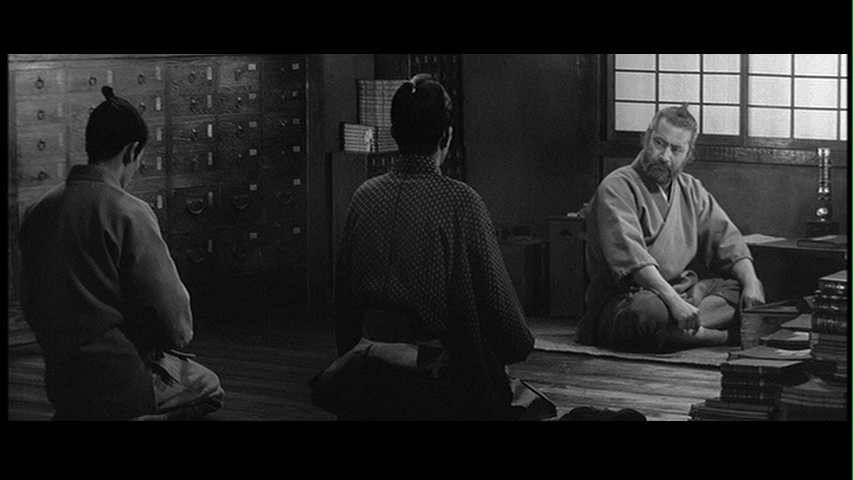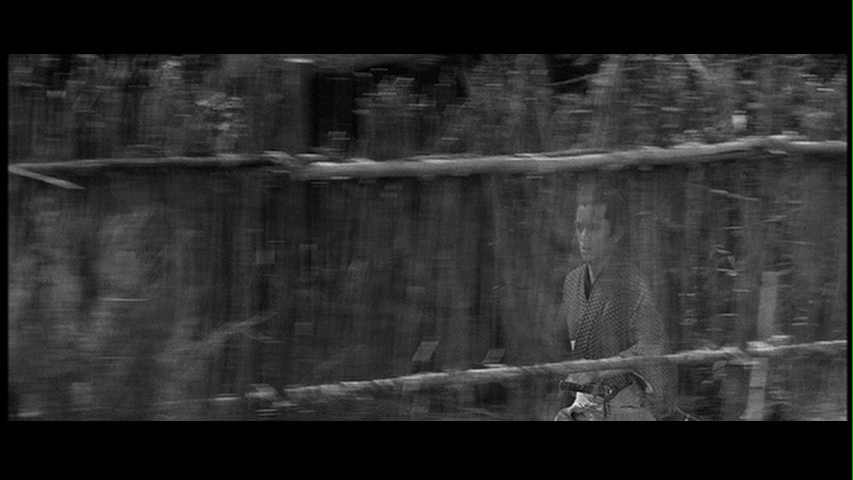Although they likely didn’t know it at the time, Red Beard marks the end of an era. It’s the end of Kurosawa’s most productive period where he directed 23 movies in 22 years; he would end up directing only seven films over the last 28 years of his career. It’s Kurosawa’s last black and white film. It was the end of a contract with Toho Studios who was finding it increasingly difficult to fund Kurosawa’s films due to their cost since television was changing the Japanese film industry, even though Kurosawa’s films were proven money winners. And it would be Kurosawa’s last film with Toshiro Mifune.
Fortunately, the behind the scenes drama doesn’t reflect at all on the final film.
Kurosawa based Red Beard on a series of short stories by Shuguro Yamamoto with a bit of Fyodor Dostoevsky’s novel The Insulted and the Injured thrown in. The short stories focus on the lives of poor individuals and a poor clinic where they end up. Kurosawa had previously adapted Yamamoto’s work into Sanjuro, so they had a natural chemistry together.
There is one overarching story to Red Beard, with essentially five vignettes interspersed throughout it. A young doctor Noboru Yasumoto (Yuzo Kayama) comes to visit a 19th century clinic. He’s recently graduated from a Dutch medical school in Nagasaki and through his family connections he believes he’s in line to become doctor to the shogunate. Much to his surprise, he learns that he’s been assigned to this clinic which comes as a blow to his ego.
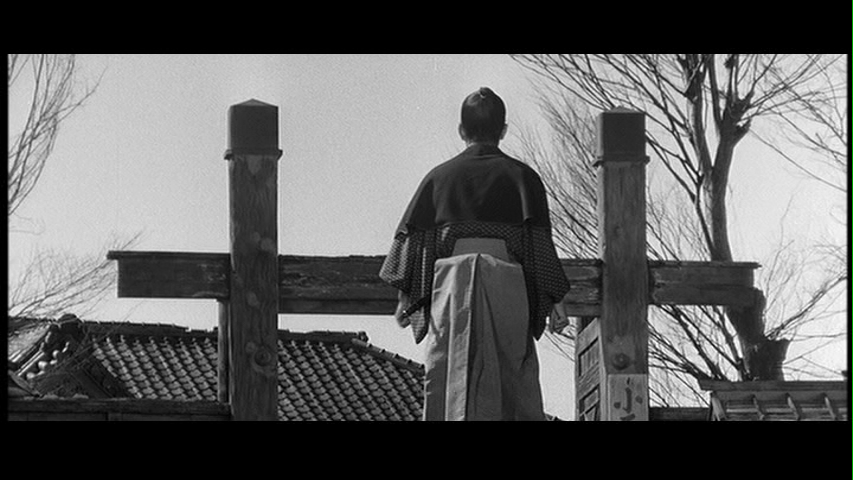
Kurosawa establishes right away that this is not going to be one of his fast paced action films. The camera lingers over the tiled roofs of the clinic as the opening credits unfold. Kurosawa is in no hurry to get through the credits in a hurry and he quickly establishes the rhythm of the film before the film proper even starts.Kurosawa slowly introduces us to all the nooks and crannies of the clinic,staff and patients (with some old favorite actors being present), and finally introducing us to Dr. Kyojio Niide (Toshiro Mifune), the titular Red Beard.
It’s quickly established that Yasumoto is quite arrogant and has no use for the poor and their suffering. He doesn’t say he views them as sub-human, but he clearly thinks the poor aren’t worth his time. Red Beard doesn’t have much sympathy for him either, although he clearly is familiar with his reputation. The fact that Red Beard wants to see Yasumoto’s medical notes right away, inspires nothing but suspicion that Red Beard wants to “steal” his methods, while Red Beard thinks there’s nothing to steal, that medical knowledge belongs to all. There’s little warmth in Red Beard’s manner and it’s hardly a welcoming situation for someone who thought he was on the way to better things. While Kurosawa is clearly setting up one of his classic mentor / student scenarios, this is one where the student is undoubtedly a reluctant one.
Of course, Yasumoto is on his way to becoming a better person, and a better doctor. That is his whole arc of the film, it just doesn’t play out in the way he thought it would. Yuzo Kayama was a popular actor of the time, known as much for his singing as his acting, and it was something of a coup for Kurosawa to get such a box office draw. Kurosawa also got a capable actor in the bargain, as Kayama manages to communicate Yasumoto’s arrogance without alienating the audience. And in his desperation, his first instinct is to run away – a beautifully composed shot from Kurosawa which is echoed, intentionally or not, in running along the beach shots in Jaws.
Yasumoto doesn’t get far as he runs into a dead end and the first vignette of the movie. At the end of the path Yasumoto runs down is a small cottage and a woman attempting to escape. It’s an intriguing image and mystery and one that demands an explanation.
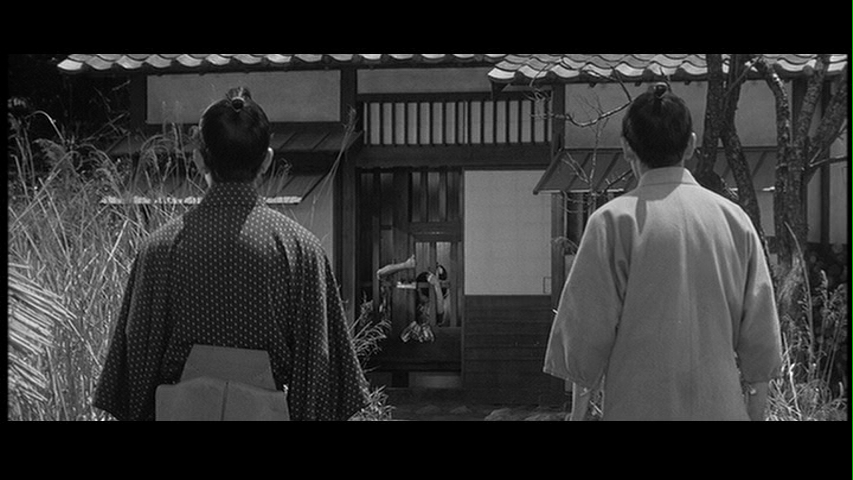
This situation is quickly explained to Yasumoto. The woman, the daughter of a rich merchant, is mentally ill and undergoing treatment from Red Beard. The woman is only identified by the nickname the Mantis (Kyoko Kagawa). She has used her beauty to lure in a pair of her father’s employees and then killed them with a hairpin. Now, she’s under guard by her nurse Osugi (Reiko Dan) while Red Beard seeks to cure her. For the first time Yasumoto is intrigued by the clinic and what he can potentially learn.
But, if he can’t escape from the clinic it doesn’t mean that Yasumoto is at all ready to be part of the clinic. Against Red Beard’s rules, he doesn’t wear the clinic robes and he spends his evening getting drunk in his room. His rebellion doesn’t last long before it’s interrupted with the news that the Mantis has escaped. Yasumoto doesn’t bother to go investigate, and it isn’t long before he’s face to face with the Mantis who has invaded his room.
Kurosawa stages the encounter between Yasumoto and the Mantis as a classical “two shot”, using a long take with the camera slowing moving in on the two of them, with both starting on opposite sides of the room and slowly getting closer. Kurosawa takes his time waiting for the proper moment to cut and increase the tension between the two. The Mantis explains her story to Yasumoto, a tale of being sexually abused by her father’s workers in the past with the threat of death if she told anyone. She continues the tale telling how those events effect her to this day and have caused her actions. Yasumoto, through a combination of pity and drink, lets down his guard and lets her get close in an attempt to comfort her. To be fair, Kurosawa stacks the deck as Kyoko Kagawa was his go-to actress at this point in his career when he wanted to break your heart, and she’s very effective in the role. At this point the Mantis pulls out a hairpin in an attempt to kill Yasumoto, an attempt that only fails due to the timely arrival of Red Beard.
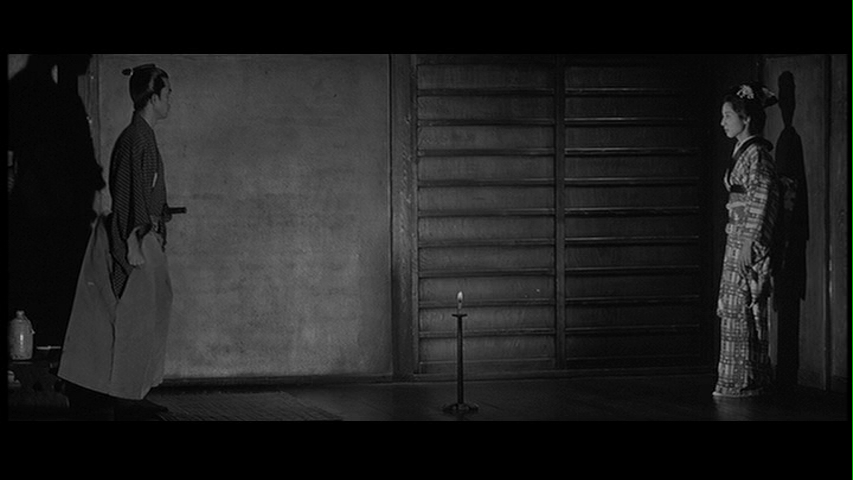
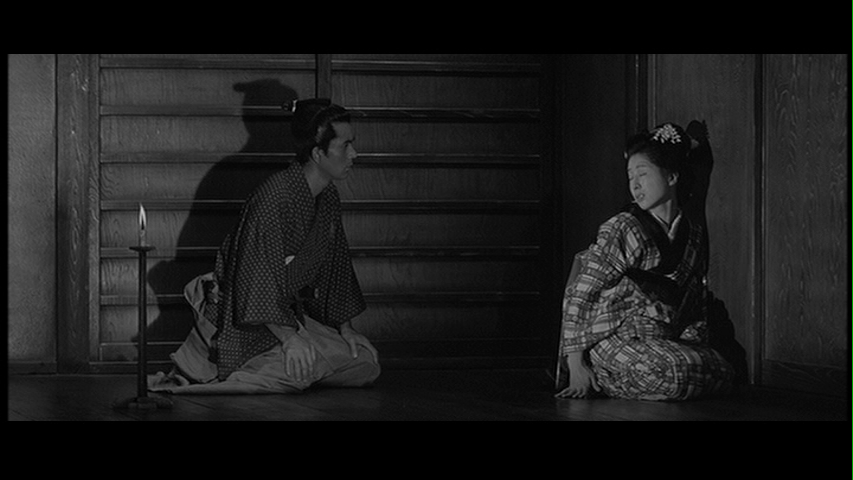
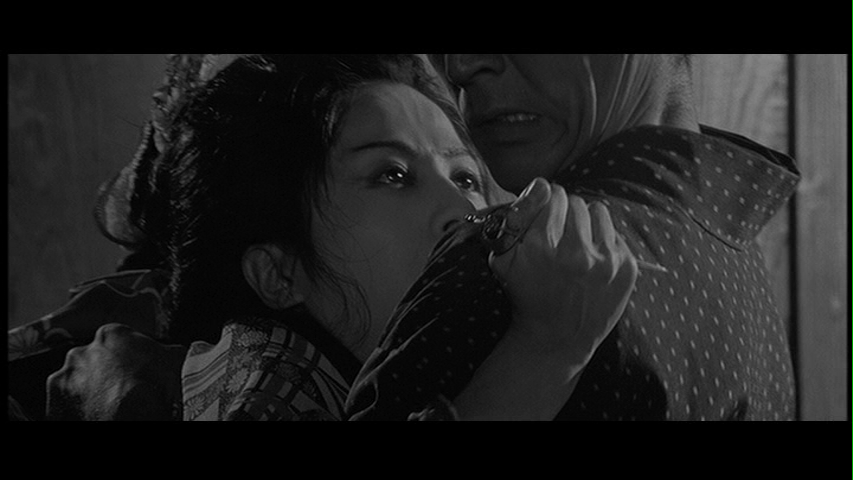
It’s at this point that Yasumoto starts to see Red Beard as someone who isn’t his enemy. Yasumoto still resents being assigned to the clinicand refuses to wear the robes, but he’s at least interested in performing the rounds. And if Red Beard wants to borrow Yasumoto’s notes, Yasumoto is no longer threatened by it.
It’s at this point that the mentor / student relationship begins to grow. While Red Beard finds some use in Yasumoto’s notes, ultimately he concludes that doctors can’t do all that much and that ignorance and poverty as often as much a problem as any disease.
To illustrate Red Beard’s point, the second vignette begins with the introduction of the merchant Rokusuke (Kamatari Fujiwara). Rokusuke is dying and there’s nothing anybody can do for him. Not that he seems to want any help, as he refuses to say anything or scream in pain, he merely gasps his breaths like a dying fish. Obviously he must be dealing with some greater pain, Red Beard concludes. Red Beard leaves Yasumoto to observe Rokuske as “nothing’s more solemn than a man’s last moments”, but it all proves too much for him as he flees the room at the first opportunity.
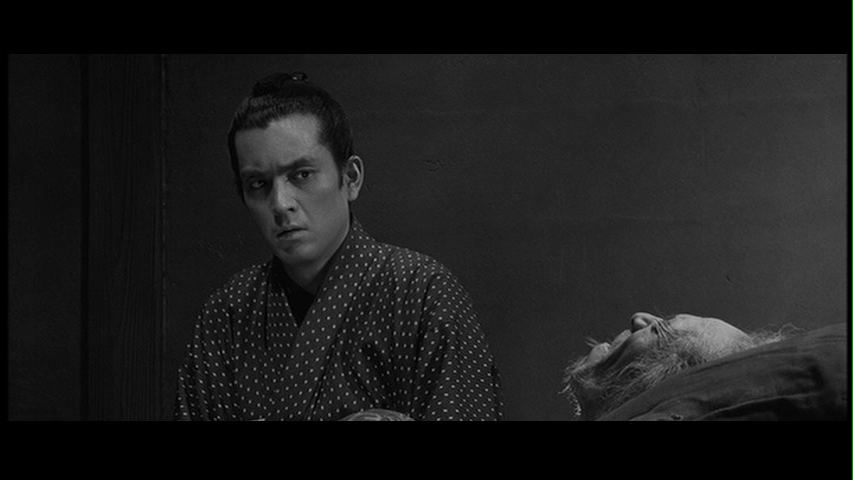
There’s no relief for Yasumoto as he finds himself immediately assisting Red Beard in surgery on a badly injured woman. Yasumoto is tasked with holding still the woman as she writhes in pain. For the first time in his career, Kurosawa handles nudity with the injured woman and it should come as no surprise that it’s handled tastefully and in a non-salacious manner as her injuries and pain are the focus of the scene. It’s so much so, that the arrogant young doctor faints from the suffering he sees. Yasumoto came to the clinic full of arrogance, but has been quickly brought down from the pure suffering he sees from the poor, quite a difference from the life of a doctor he envisioned under the shogunate.
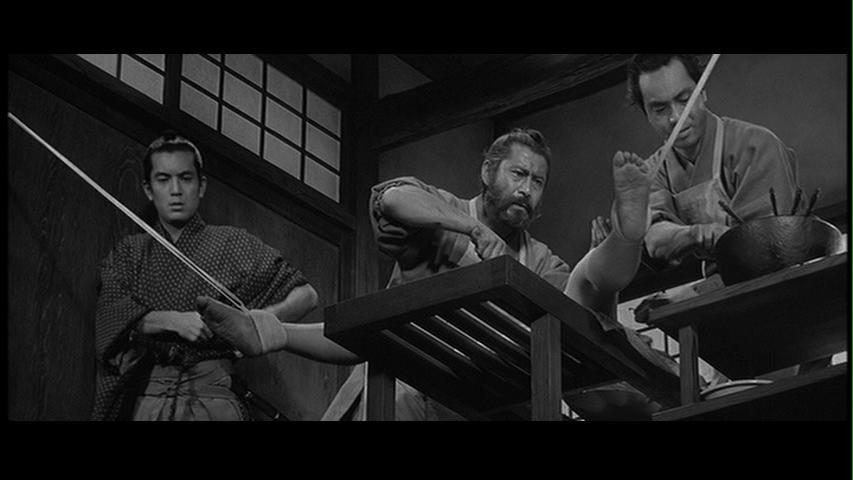
Surprisingly, Red Beard shows understanding towards Yasumoto’s fainting. Red Beard may be set in his ways and stern, but he’s not unfeeling. If anything, Red Beard is quite the opposite. A point that’s made clear when Rokusuke’s daughter Okuni (Akemi Negishi) comes to the clinic only to find that her father is dead without the two of them reconciling. In a scene of long takes with a focus shifting between the room and the daughter, Red Beard, Yasumoto, and the audience hear her tale of woe.
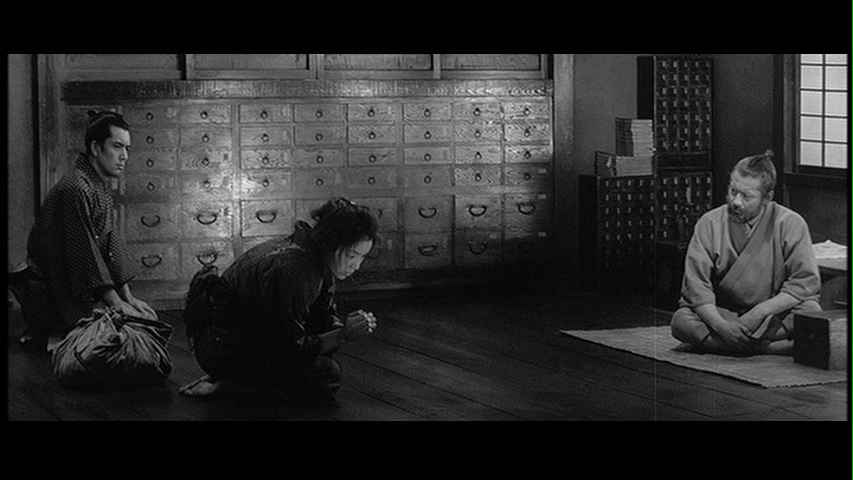
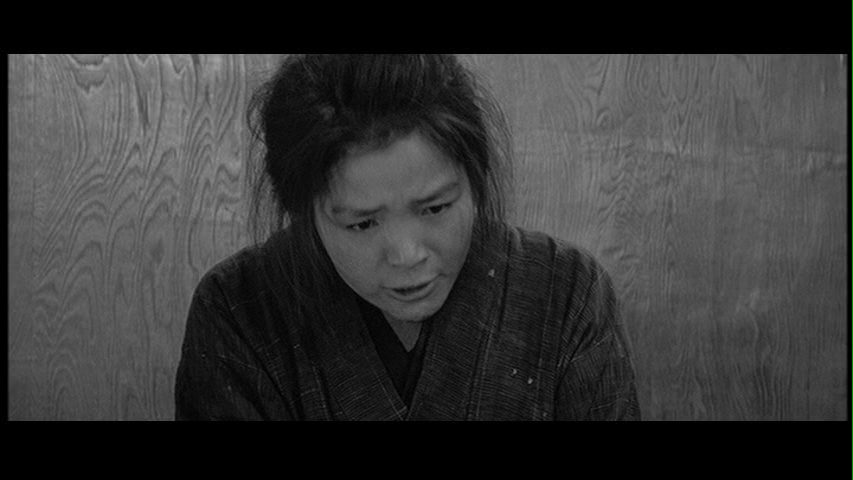
Rokusuke had a wife that was unfaithful to him with another, much younger man. Eventually Rokusuke’s wife ran away with the man and her daughter, confused by her parents, went with her mother. The mother eventually arranged for her daughter to marry the man, in order to keep him close. The daughter had three sons, but was mistreated and discovered that her mother and her husband were still continuing their affair. She initially refused Rokusuke’s entreaties to return out of shame. But, after the death of her mother and a fight where she stabbed her husband, she’s left only to discover her father died without knowing that she didn’t return out of hate, but out of shame. Now she faces arrest and her sons face abandonment or abuse.
Akemi Negishi has one scene to make an impression and she makes the most of it. So does Akira Kurosawa. We’ve had two scenes with women relating tales and he filmed the scenes in significantly different styles to keep the movie fresh and involving.
Red Beard doesn’t add to her pains by telling her that her father died in great pain, but rather says he died peacefully. It’s a lie, which Yasumoto reacts to, but he sees the wisdom in it. Red Beard also chooses to intervene with the magistrate on the woman’s behalf. Apparently he knows a thing or two that the magistrate would rather be kept concealed. Red Beard couldn’t save her father, but he can keep her out of jail and give her a chance for a future. It’s at this point it’s clear that the story is less about medicine and more about doing right with social justice.
We also see the contrast between Mifune as Red Beard and his past roles. Mifune treats the character very, very seriously. Red Beard comes back and regrets having to essentially blackmail the magistrate to do right. And it’s not a regret tinged with sarcasm or cynicism as you would expect from Sanjuro who would be happy just to get the job done. It’s not enough for Red Beard to do right; he wants to do right with honor. Red Beard is not living a comfortable existence, like a television doctor that will often go home to a plush lifestyle, but he lives little better than his patients.
All of this makes an impression with Yasumoto as he takes another step in his journey.
Which brings us to our third vignette, which had been interweaved earlier, of Sahachi (Tsutomu Yamazaki). Sahachi is a beloved, selfless worker, he works against doctor’s orders in order to provide money for food and blankets for his fellow patients. But his selfless efforts have just made his own illness worse and now he’s dying. As a last request, he’s taken back to his residence where all the tenants come to pay their respects and a torrential rain falls.
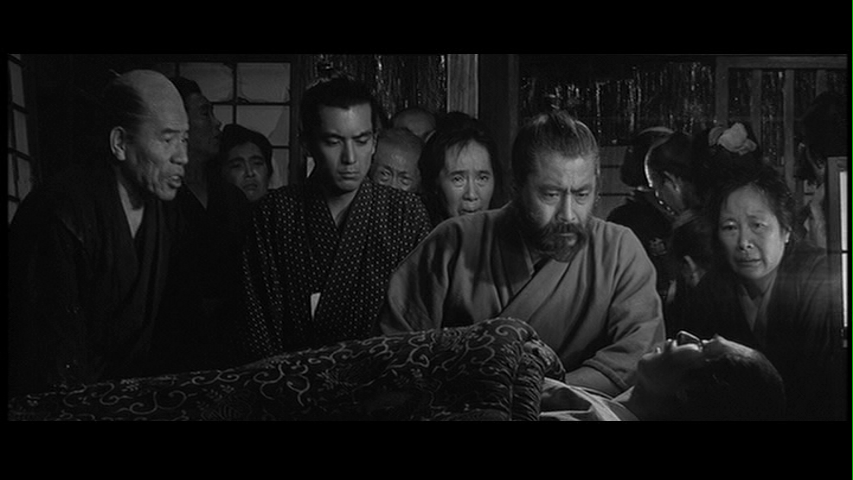
The rain causes a landslide on the nearby hillside which uncovers a skeleton. Shortly afterwards Sahachi tells his story revealing that the skeleton is of his wife and how she came to be in that grave. Kurosawa tells this story through flashbacks, in contrast to the earlier two vignettes. There are even flashbacks within the flashback. Again, Kurosawa understands that while the stories may have similarities, you can tell them in starkly different visual ways.
Sahachi’s wife, Onaka (Miyuki Kuwano), was a woman he met and instantly fell in love with. Onaka reluctantly agrees to be his bride, but they both were very happy. Until an earthquake hit and Sahachi was unable to find her body in the wreckage.
A year passed, and in a random encounter Sahachi finds Onaka. Only she is nursing another man’s child now. Something that he’s not able to reconcile, until he wakes up late at night and finds Onaka in his room. At that point, she tells Sahachi her story, how she was promised to someone else that was kind to her family and that she broke that promise to be with the man she truly loved. She was happy, until an earthquake hit which she took as a sign of her own wrongdoing and a sign that she didn’t have the right to be happy.
Red Beard is an intimate movie from Kurosawa, but with the flashback he allows for some larger than life scale as we see a building collapse in the earthquake and Onaka wander through the wreckage.
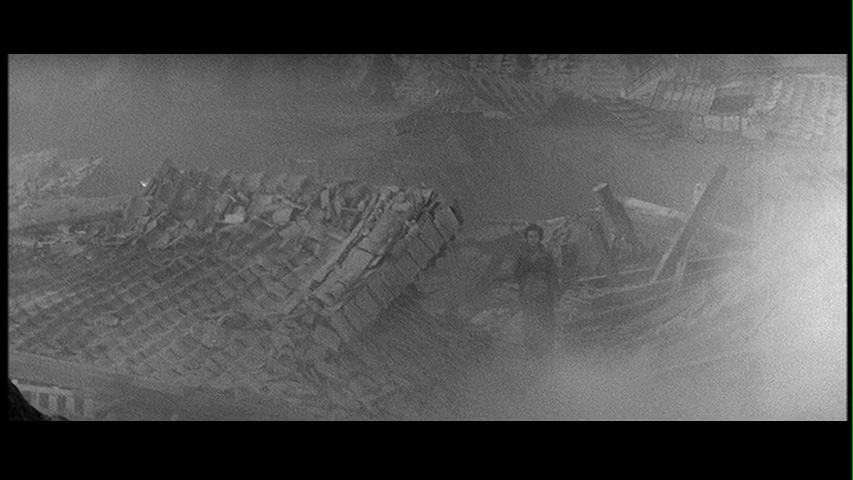
Kurosawa uses smoke to imply a lot of carnage that we don’t see. There’s a particularly striking series of shots as we see Onaka’s internal conflict with the sun squarely framed in the background which comes and goes with the breaks in the smoke, sometimes the image is clear, sometimes the image is obscured by the sun, and in all cases it’s emblematic of the internal conflict.
Onaka used the devastation to flee with the assumption that she would be presumed dead and that Sahachi would move on. That he hasn’t causes her pain and brings up all of the old emotions she’s felt. Ultimately she kills herself, to move on to a state where she can be happy with honor.
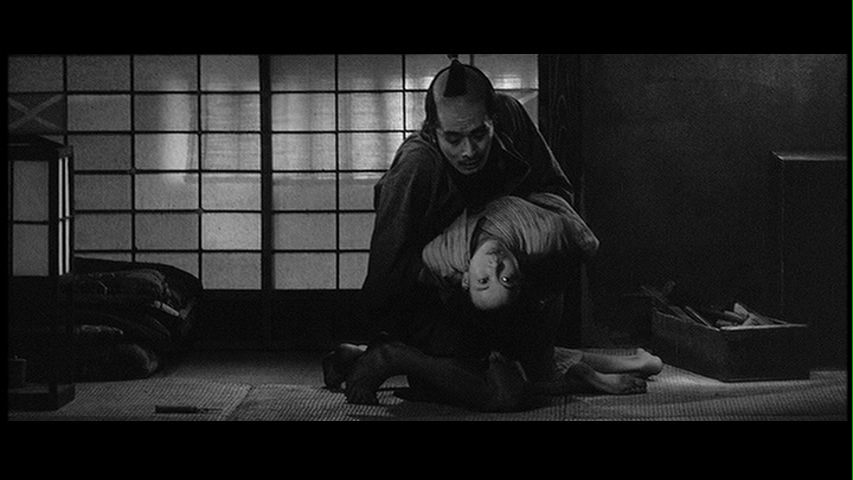
Sahachi decided that the least he could do is make the world a better place so that no one believed they were undeserving of happiness and to atone for his own perceived selfishness. He lived a life of helping others and his reward is to die surrounded by people that love him.
It’s at this point that Yasumoto decides he’s willing to put on the robes of the clinic, as he makes another step in his character arc. The film shifts at this point being less concerned with the past of the patients; Yasumoto and Red Beard come in contact with and more concerned with the present and future. And we start to get our first glimpses into Yasumoto’s past.
As their relationship grows, Red Beard brings Yasumoto along with him as they make the medical rounds. A lord who isn’t sick, but merely eats and drinks to excess, but who pays well to support the clinic. And their rounds take them to a brothel. While on their way, we discover that Yasumoto had a tough time with his former fiancée who ran away with another man while he was in medical school. It gives insight into why Yasumoto has been slow to make connections, while the story has been forcing him to learn the history of those he’s treating.
The brothel is an awful establishment with the Madame being a real piece of work. But a twelve year old girl, Otoyo (Terumi Niki), catches Red Beard’s eye. Otoyo has fallen into the hands of the brothel and while she refuses to prostitute herself, she’s been forced into service with the reflex action to systematically scrub the floors. Red Beard diagnoses that she’s also suffering from a fever and could die and immediately wants to remove her to the clinic, over the protests of the Madame and her enforcers.
Protests that prove short lived as Red Beard beats the tar out of the Brothel’s enforcers, and breaks several arms in the process. Of all the things to expect in a 19th century drama about medicine and doing right by the lower class, a martial arts fight has to be among the last things that people would expect. With a point of humor that Red Beard takes the time to set all the broken limbs he was responsible for afterwards.
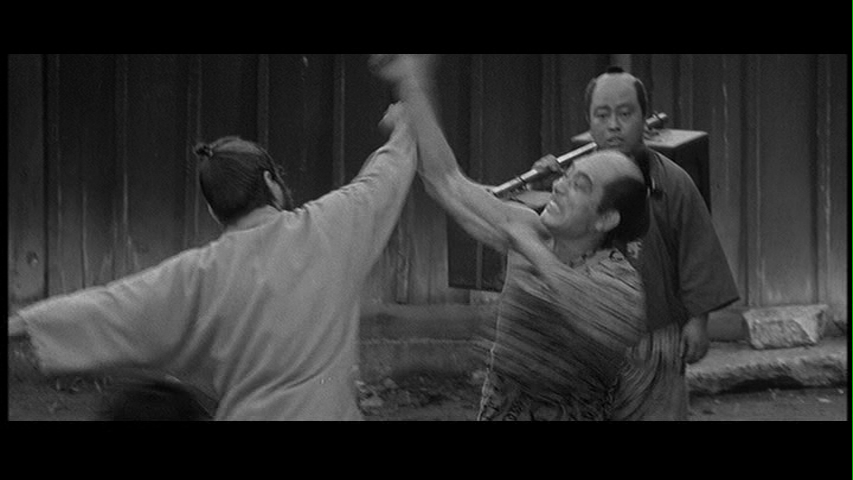
Red Beard assigns Otoyo to Yasumoto as his first case, which officially begins the fourth vignette. Kurosawa used Dostoevsky for the source of Otoyo’s story rather than Yamamoto, so it’s easy to look at this as being a story to which Kurosawa was strongly attached . And, again, it’s a story arguing for the basic worth of a human being.
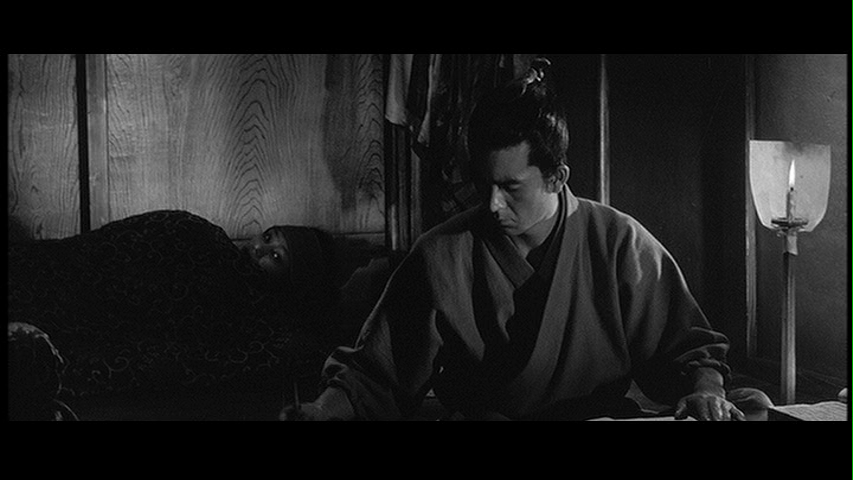
Kurosawa makes sure that the story stands out by adopting another strategy for telling the story. In this case, he uses voiceover narration of Yasumoto’s diary entries as he cares for Otoyo. Which proves to be more difficult than he anticipates as Otoyo is tremendously distrustful. But through patience and kindness on the part of Red Beard and Yasumoto, they start to win her over.
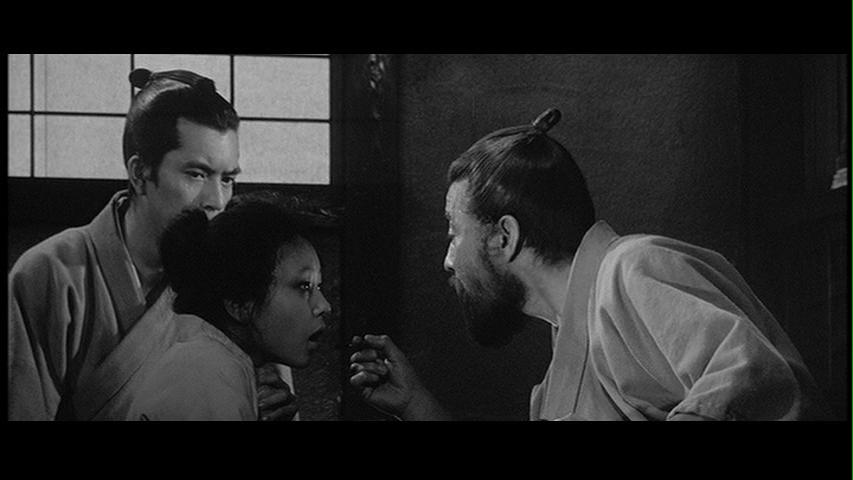
Entwined with Otoyo’s story, we learn more of why Yasumoto is at the clinic. The fiancée who ran away from him was the daughter of the doctor who was recommending him to the shogunate. The resulting scandal against the fiancée’s family is part of the reason that Yasumoto ended up at the clinic,and Yasumoto hasn’t gotten over it yet. That and Red Beard found out about the circumstances and arranged the clinic to be a destination for Yasumoto.
During the course of care of Otoyo, Yasumoto catches the fever. And, as repayment for his kindness, Otoyo nurses him back to health. It’s symmetry as Yasumoto’s kindness is repaid.
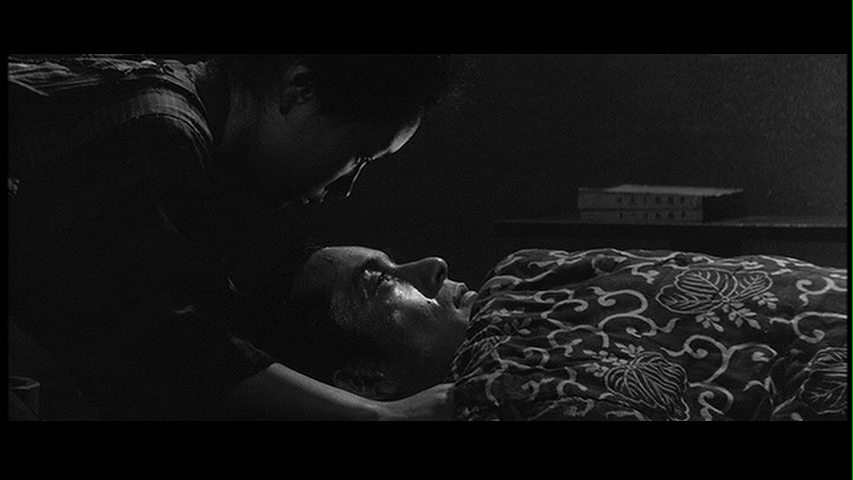
Which brings us to the final vignette of the film, which interweaves with Yasumoto finally coming to grips with his place in the world and his future. Yasumoto is offered the opportunity to end the bad situation between two families by marrying the sister, Masae (Yoko Naito), of the woman who betrayed him. This draws the jealousy of Otoyo, who unaccustomed to gratitude is untrusting of anyone else getting Yasumoto’s attention. While sulking, she lets a little boy steal gruel from the clinic through clever means.
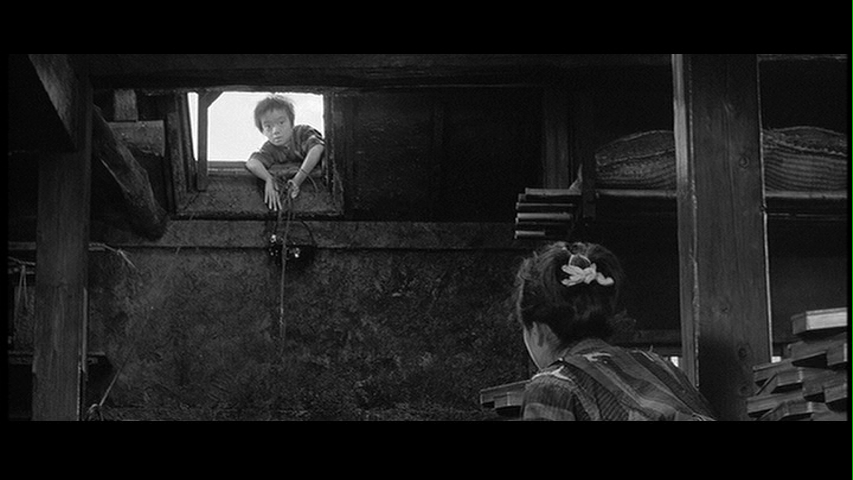
Later Otoyo befriends the boy who we learn is named Chobo (Yoshitaka Zushi). Chobo’s family is in desperate poverty, so he’s stealing food to survive. Even though he knows it’s wrong and would bring shame on his family. That story draws the pity of Otoyo. And of Yasumoto and a head nurse who overhear the story. Like in Seven Samurai with the old beggar woman, the head nurse conspires to help feed Chobo without letting Otoyo know.
Kurosawa chooses a straightforward presentation for the last vignette, fully integrating it with Yasumoto’s arc. Kurosawa doesn’t skimp on the style, he uses a crane shot for much of Chobo’s story focusing on his story and the reaction of the hidden listeners, but everything converges into one story and one style.
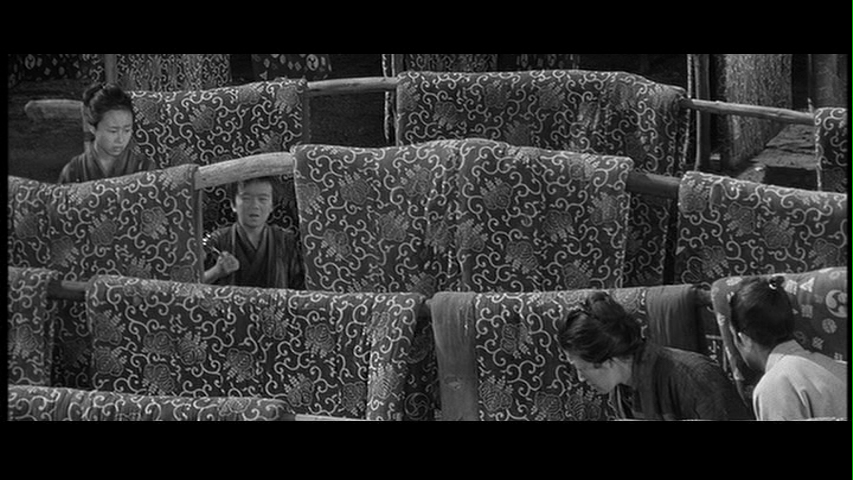
The climax has a family brought in which has poisoned itself. It turns out to be Chobo’s whole family has chosen to commit suicide because of the shame of his being a thief. The doctors do their best to save them, but ultimately it’s up to nature to run its course. Which doesn’t sit with Otoyo, along with the nurses, fulfills an old superstition of running to a well and yelling the name of those on death’s door to call him back from the land of the dead. The well shot, a reflected shot off the water which doesn’t reveal the camera, is one of Kurosawa’s strongest images of the film and shows him at the top of his game.
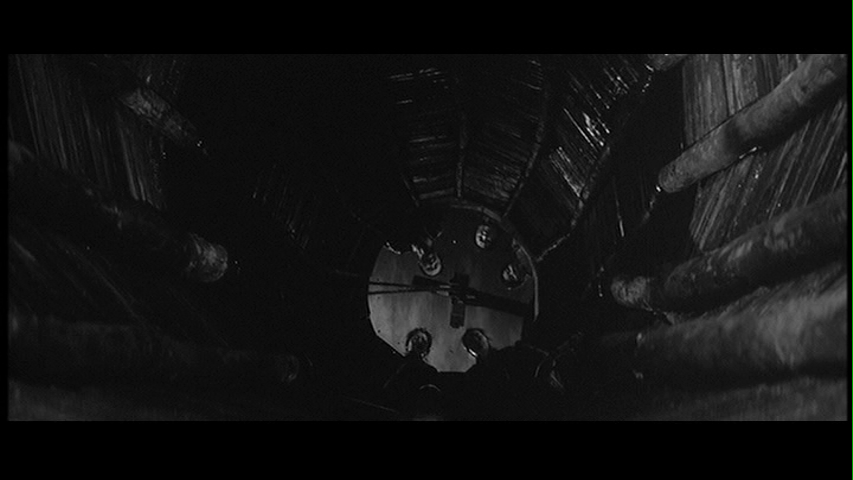
Chobo lives and Yasumoto chooses to marry Masae. And, at the wedding, Yasumoto makes one more decision. He offers his bride the choice to marry him, but she must understand that Yasumoto won’t be a shogun’s doctor, he’s determined to be a part of the clinic, no matter how hard it may prove. Charity and humanity have won the day over selfishness.
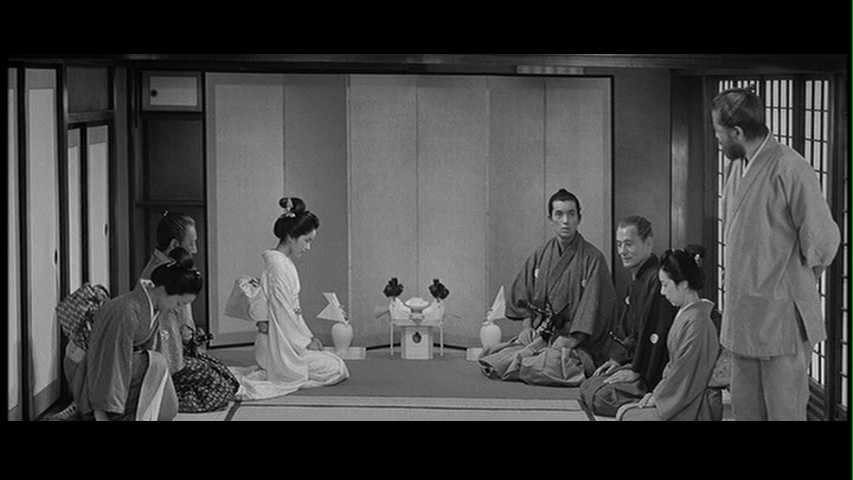
Red Beard is a remarkable film. The period detail of the film is magnificent, the stories intertwined with the narrative are all heartfelt, and the central performances are terrific. It’s not quite up to Kurosawa’s very best films, the film is perhaps too straightforward and slightly long for that, but it’s a terrific film altogether.
Red Beard was a tremendous hit in Japan and many considered it the finest Japanese film of the year. It wasn’t as immediately celebrated in the west, perhaps because it came after exciting powerhouses like Yojimbo, Sanjuro, and High and Low, but it was still well received. Everyone seemed happy with it, except apparently for Kurosawa and Mifune.
It was a long, difficult shoot lasting over a year of production during which Mifune had to maintain his beard which caused him to turn down other work, which lead to some financial distress.. To top it off, Kurosawa’s scriptwriter Hideo Oguni thought Mifune’s performance was “all wrong” and told Kurosawa and Mifune as much, a view I and others don’t hold. Kurosawa apparently entertained that notion though and it caused a rift in his relationship with Mifune. By all reports, it wasn’t a bitter feud or anything really dramatic, but the two of them never worked together again.
It’s at this point, that Kurosawa’s career took a turn for the worse. Although it wasn’t immediately noticeable as Kurosawa still had many opportunities. Hollywood even came calling offering him a chance to co-direct Tora, Tora, Tora: telling the raid on Pearl Harbor from the Japanese point-of-view. Kurosawa worked on the film for several years, but it ultimately fell apart for Kurosawa due to conflicts with the studio. For one thing Kurosawa didn’t feel his co-director Richard Fleischer was of sufficient stature, and Kurosawa was growing increasingly erratic due to health concerns, both mental and physical. It was a great debacle for Kurosawa, with problems exposed in his own production company which lead to it shutting down. He’d gone from the top of his career to needing to rebuild in a few short years.
Kurosawa then chose an unlikely vehicle for his next film; an experimental film, with a limited budget, and using color for the first time in Kurosawa’s career focusing on the lower depths of society. It was a film that came very close to being Kurosawa’s last.
Next Time: DODES’KA-DEN (1970)
